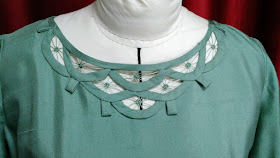A Fabulous Vintage Find
 |
| Design by Nicholas Ungar |
Such was the case on a trip up the Oregon Coast, where I found this dress and jacket with a Nicholas Ungar store label.
 |
| Nicholas Ungar Label was a popular store out of Portland Oregon |
This couture vintage dress and jacket dating from the 1950s was created from a demure jade shantung silk and is full of intricate details and novelties. This outfit was likely worn for-day time excursions or less formal evening soirees. It has quite a lot of hand stitching (the definition of couture) but whether it was made specifically for the customer or not, it's hard to say. Nicholas Ungar was a store in Portland Oregon, and was successful enough to be purchased by Nordstroms in the 1960s.
 |
| Nicholas Ungar design comes with a matching jacket |
As was common, the seam finish is pinked on most edges and the metal zipper, or "slide fastener" as it was once called, is typical of clothing manufactured before the mid-'60s.
 |
| Pinked Seams |
The wide seam at the waist perhaps means that the store provided for some alteration there, and here you can see the waist stay made from rayon hem tape sewn into the seam. A waist stay was typical of higher quality as is used to keep the waist seam from stretching out, thus keeping the silhouette as trim as possible.
 |
| Waist Stay |
One thing that surprised me was that the dress wasn't fully lined. Generally you'd find a dress of this caliber lined completely, but here you can see where facings were used. Nice wide ones at that.
 |
| Inside Facings |
Two metal zippers were used (too early for plastic), one short back zipper and the other at the side. Side zippers were so common that the zipper design was made exclusively for this use and includes a stop at both the top and the bottom. Today we improvise using a zipper with a top opening.
 |
| side zipper |
The detail on this neckline is the real show stopper on this dress. Long bias tubes pressed flat were used to create the intricate scallop design. They were hand shaped, tucked into place, and stitched together. Faggoting stitched in a star pattern helps to hold and decorate the open areas.
 |
| Beautiful faggoting at neckline |
Here's a view from the inside. To duplicate a detail like this, home sewists would baste the garment to several layers of newspaper to stabilize it. With everything basted in place, the tubing was added, shaping as they go, then stitched in place. Heavy thread could then be strung between each side of the openings to create the star pattern we call faggoting.
 |
| Hand Stitched Inside |
The bound buttonholes are also sometimes called "welt" buttonholes because they are made nearly the same as a welt pocket, only smaller. The photo below shows the wrong side of the button hole and how they've hand stitched the facing to the welt.
 |
| Bound Buttonholes |
There is a 3" hem, hand sewn with hem tape. With a fabric as fine as silk, every lump and bump shows. Using hem tape avoids the thickness of multiple folds. (Hem tape is also a great for bulkier fabrics for the same reason.)
 |
| Hem |
I don't know much about this store designer. Do you?
 |

Two more Nicholas Ungar designs.
I'm sorry this dress doesn't fit me "as is" but it fits perfectly into my small but special vintage clothing collection. What have you found in your searches for vintage fashion?
Have a great sewing day!
Laura

Love the intricate faggoting, I never would have guessed how they made that neckline
ReplyDeleteI've had several favorite vintage items, but the ones I pour over and over are all hand made. Even the home made ones show a level of care and intention I have not seen in more recent things, even in designer goods.
ReplyDeleteMy big weakness: welted buttonholes.
Thank you for your comment SJ. I think welt buttonholes were more common too. I would guess fewer people had the buttonhole attachment and a welt is fairly easy to do. It comes out looking very nice for the home sewist. Compare that to our constantly busy modern lives and the automatic buttonholer on every machine.... it would be nice to slow down and enjoy the welt buttonhole again! :-)
Delete